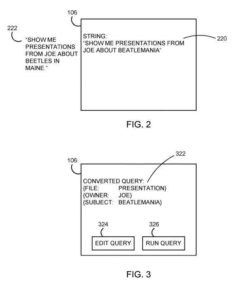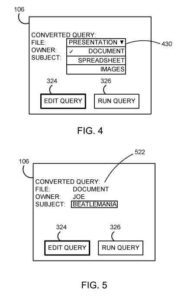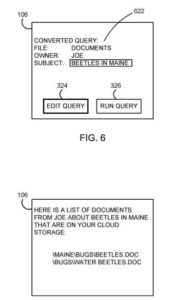Table of Contents
A newly granted Google patent has come out about processing and editing natural language queries.
As seen from Google, patents assigned to the search engine provide us with insights about processes developed at Mountain View, Ca. This one lets us look at how Google is working on editing natural language queries.
Last May, I wrote about another Google Patent in a post worth revisiting called: Natural Language Query Responses.
Related Content:
- Technical SEO Agency
- Ecommerce SEO Agency
- Shopify SEO Services
- Franchise SEO Agency
- Enterprise SEO Services
Computing systems capable of editing natural language queries interpret the user’s statement and immediately take some action, such as performing a search or generating an item.
But, if the machine interpretation of the user’s statement is off by a single word or a slight nuance, the interpretation of the statement can be completely wrong, useless, and even detrimental. To remedy this, existing systems require the user to repeat the entire statement, possibly varying a few words, to achieve the desired result.
Systems and methods get disclosed herein for editing natural language queries. A receiver circuitry receives the natural language query from a user. A natural language interpreter circuitry parses the natural language query to convert the natural language query into several categories and several variables. Each variable in the number of variables corresponding to one class in the number of types.
A user interface displays the number of categories and the number of variables. It allows the user to change at least one variable in the number of variables by providing a natural language utterance.
Processing Natural Language Queries
Another aspect relates to a system including means for editing natural language queries. Receiving means receiving the natural language query from a user.
Natural language interpreting means parsing the natural language query to convert the natural language query into several categories and several variables. Each variable in the number of variables corresponding to one class in the number of types.
Interfacing means displaying the number of categories and the number of variables and allowing the user to change at least one variable in the number of variables by providing a natural language utterance.
The natural language query is a request to display a list of files on a web-based storage system. The number of categories may include at least two of:
- File type
- File owner
- time
- location
The method may further include means for filtering a number of user files on the web-based storage system based on the prevalence of categories and most variables.
The user modifies at least one variable by selecting at least one variable and speaking a phrase to replace at least one variable. The system may further comprise means for allowing the user to change the natural language query by saying a word to add one or more categories and variables to the natural language query.
The system may further comprise means for determining whether to update the natural language query or generate a new query based on many categories and variables in the natural language utterance provided by the user.
Allowing the user to change at least one variable may get a modification to the natural language query, and the means for allowing the user to modify at least one variable may further enable the user to undo the change to return to the natural language query.
Filtering Lists of Natural Language Queries
The system includes filtering a list of items based on categories and variables, providing the filtered list of items to the user, and flagging items in the filtered list of things in response to receiving a user request to flag the items.
In response to receiving a user input indicative of a request for a machine-generated natural language query that would result in the number of categories and the number of variables, the interfacing means may further provide the machine-generated natural language query to the user.
Editing Natural Language Queries
A system for editing natural language queries – in particular, a device gets described that allows for efficient processing and editing of queries in a natural language format. But, it will get understood by one of ordinary skill in the art that the systems and methods described herein may get adapted and modified as is appropriate for the application getting addressed and that the systems and methods described herein may get employed in other suitable applications, and that such other additions and modifications will not leave from the scope thereof.
Generally, the computerized systems described herein may comprise one or more engines, which include a processing device or devices, such as a computer, microprocessor, logic device, or other device or processor that gets configured with hardware, firmware, and software to carry out one or more of the computerized methods described herein.
The patent provides for editing and processing queries in a natural language format. The device described is easy to use and allows a user to give instructions to a device for displaying and organizing documents. The systems and methods described overcome many technical difficulties associated with existing natural language interpreters and get described as a web-based storage system, which may communicate with other systems over a network to store and share user data.
In general, one of the ordinary skills in the art will understand that the systems and methods described herein apply to systems that get interconnected without departing from the scope thereof.
Systems and methods for editing and replaying natural language queries
Inventors: Robert Brett Rose, Gregory Brandon Owen, and Keith Charles Bottner
Assignee: Google LLC
US Patent: 11,288,321
Granted: March 29, 2022
Filed: May 30, 2019
Abstract
A sign of a first natural language utterance identifying a user request gets received. A natural language query gets generated based on the first natural language utterance. The natural language query comprises
(i) a plurality of categories, and
(ii) a plurality of variables.A sign of a second natural language utterance identifying a modification to the user request gets received. Whether to change the natural language query or to generate a new natural language query based on the second natural language utterance gets determined.
Responsive to determining that the natural language query is to get modified based on the second natural language utterance, at least one of the plurality of variables of the plurality of categories of the natural language query gets modified to correspond to the second natural language utterance. A response to the user request gets provided based on the modified natural language query.
Editing Natural Language Queries Conclusion
The earlier patent on Natural language processing goes into more detail on grammar rules. This one clarifies that the Google search engine uses natural language processing in the communication between it and humans using it to search. I’ve summarized the summary of the patent., skipping past the legal analysis behind the patent filing. I have also been writing about Human to computer dialog patents from Google which also focus on how people and computers interact with each other. This is a movement towards better input and question answering with the search engine.
Search News Straight To Your Inbox
*Required
Join thousands of marketers to get the best search news in under 5 minutes. Get resources, tips and more with The Splash newsletter:


